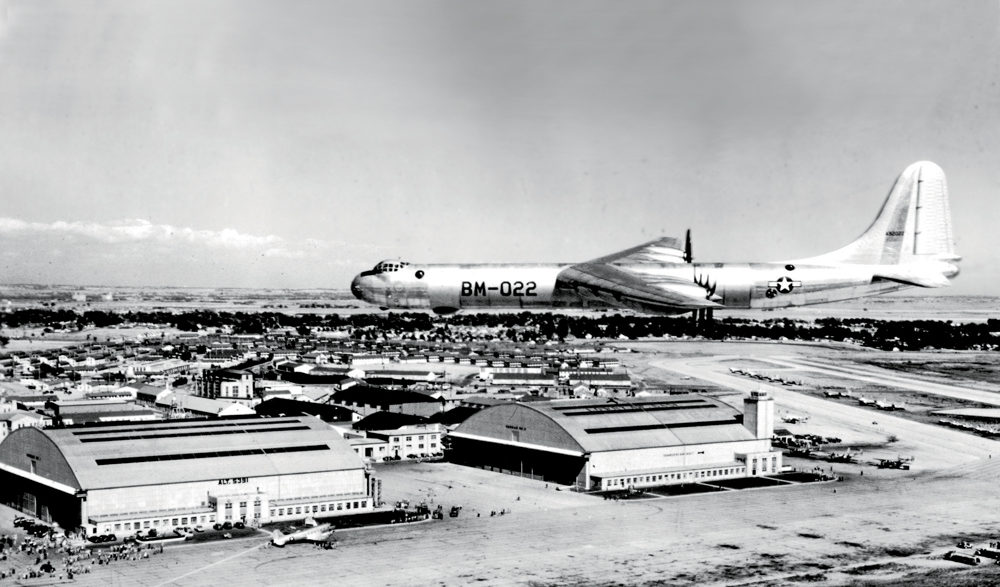
A B-36 bomber flies over Hangers 1 and 2 at Lowry.
Lowry Anniversary Events
Friday, October 4, 2019: Happy Hour at Lowry Beer Garden, 7577 E. Academy Blvd., 3–6pm
Saturday , October 5, 2019: Family Friendly Day at the Museum. Regular Wings admission, 10am– 2pm. Historical tours departing from Wings.
25th Anniversary Event, 5:30pm–10pm. Live music, dancing and more. Small bites and craft beverages (cash bar.) $35 General Admission / $25 Veterans. Tickets: LowryFoundation.org/silver-anniversary
Hosted by Lowry Community Master Association and Lowry Foundation, together with Wings Over the Rockies and others.

The giant B-52 bomber at Wings Over the Rockies Air and Space Museum, the second oldest of its kind in existence today, dwarfs the passing visitors. Hangar 1 at Lowry was given to volunteers in 1994 by the U.S. Air Force to establish the Wings Museum, which today includes more than 182,000 square feet of hangar space and 50 aircraft dating from 1939 to 1990. In the background is Hanger 2, which today houses multiple local businesses.
Lowry Air Force Base closed 25 years ago, but the Lowry neighborhood redevelopment retains its history in 30 original buildings, as well as design elements that acknowledge the area’s storied past. “Our intent was not to scrape away the history and build everything new,” says Monty Force, executive director of The Lowry Redevelopment Authority. “Lowry Air Force Base was a community for nearly 70 years. Our mission has been to retain that history as we transform into a new community.”
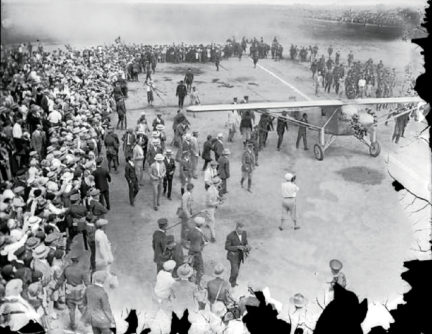
Thousands gathered to greet Charles Lindbergh when his “Spirit of St. Louis” touched down at Lowry Field in 1927. It was one of 82 stops in the U.S. following his flight from New York to Paris in May that year.
Lowry Air Force Base was preceded by Lowry Field, an airstrip built in 1926 at E. 38th Ave. and Dahlia St., where Colorado National Guardsmen received flight training. Lowry Air Force Base opened five miles away in 1937, at 6th and Quebec, with its operations focused on technical training, including flight training, aerial photography, weaponry and metrology (the science of measurement). “More than 1.1 million people came from all over the world, from all branches of the military, to train here,” said Jeane Larkins, executive director of The Lowry Foundation.
Lowry Air Force Base closed its doors in September 1994, as part of a 127-base closure during the Clinton administration. Its 1,866 acres were conveyed in parcels to The Lowry Redevelopment Authority, a quasi-governmental, nonprofit entity created by the cities of Denver and Aurora. Lowry is 89% in Denver and 11% in Aurora. “An intergovernmental agreement between the two cities set up the charter, with board members appointed by the two mayors,” said Force. “Tax increment financing, now paid off, helped with the demolition and built parks and the Lowry Elementary School.”
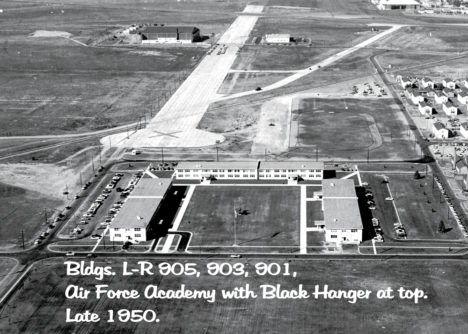
The Black Hanger referenced below was a high security building nicknamed “The Black Shack.” It was used as a training site for sensitive weapon systems. Following the closure of the base, it became Big Bear Ice Arena.
Force said the challenges of redeveloping Lowry included inheriting an obsolete infrastructure and useless runways. “We had to rebuild all of the infrastructure and tear out the runways. Runways don’t make good roads because they are flat, and they don’t drain.” He said contaminates were remediated from the groundwater and the soil, including TCE from solvents used for cleaning airplane parts; oil and gas spills; and asbestos from previous demolition.
The current neighborhood is home to 25,000 residents and workers and includes 100 employers. When the last 80-acre parcel of land is redeveloped, Lowry will have 5,600 residential units. About 17% of Lowry homes are in the affordable program, Force said, including 200 for-sale units and 800 rentals. Boulevard One, the newest parcel to be completed in 2022, will include 14 designated affordable for-sale units and 72 affordable rentals.
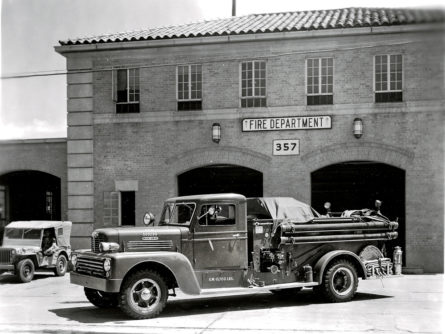
Building 357, the fire station, is now the home of Colorado Free University.
Boulevard One, at 1st Ave. and Monaco, was once the tail end of Lowry’s Runway One. “Airplanes taxied onto the tarmac there,” said Hilarie Portell, director of public relations and marketing for the Lowry Redevelopment Authority. “The other runways were Lowry Blvd. and Uinta St.”
Lowry suspended aerial operations in 1966. “Denver was growing all around the base and it was becoming dangerous,” said Larkins. “Lowry stopped aerial operations after a plane crashed into a home.”
Various celebrities have been a part of Lowry’s history. Charles Lindbergh landed at Lowry Field on August 31, 1927, after completing the first solo flight over the Atlantic Ocean in May of that year. The Glenn Miller Story, a 1954 movie starring Jimmy Stewart about Colorado’s famous World War II bandleader, was filmed in part inside a Lowry hangar. During the 1950’s, Lowry AFB was President Dwight Eisenhower’s summer White House and the first couple attended services at Chapel Number 1 (now Eisenhower Chapel).
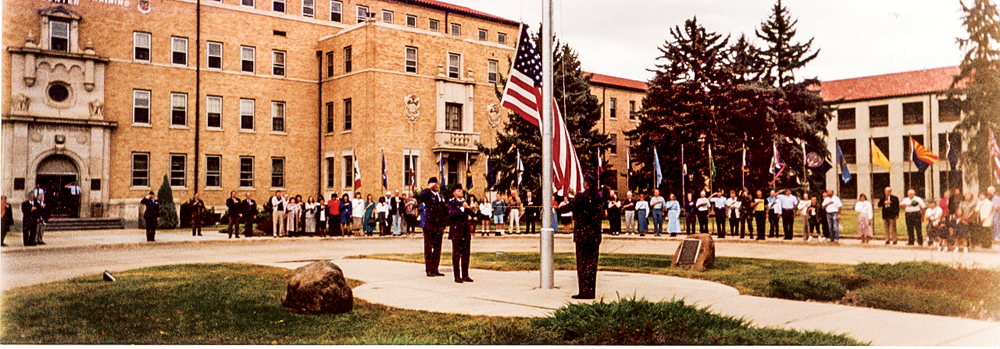
The flag was lowered during a ceremony in Sept. 1994 as Lowry Air Force Base was decommissioned.
The U.S. Air Force Academy was located at Lowry AFB from 1955-58, while the permanent campus was being constructed in Colorado Springs.
Larkins, who leads tours of the historic Lowry sites, said former servicemen and women often visit and share their experiences at Lowry. Some history will never be shared, however, since the base was under tight security because of research and development of ballistics, including bombs. “One visitor in her 80s said she still isn’t permitted to talk about what she did here,” Larkins said.
Building 1499, known to Lowry’s military residents as “The Black Hangar,” was a training site for various sensitive weapon systems, including nuclear weapons. The building has been repurposed as Big Bear Ice Arena.
Other Air Force buildings that were saved and repurposed include the Lowry Fire Department, now John Hand Theater; the steam plant with its original stacks, now 14 condos; and the prison, now part of a school. Force’s office is in the former photography school and Larkins’ office is in Eisenhower Chapel.
Lowry’s new buildings and public spaces incorporate the flavor of the neighborhood’s history. “We used elements of the original buildings to inform new construction, like the blonde brick, also barrel roofs that are reminiscent of hangars,” said Portell. “The Air Force star-circle graphic is used in our public spaces, in the sidewalks, metalwork and fencing. Residents love the sense of local identity.”
“This is a unique community with a character all its own,” said Force.
Historic photos courtesy of The Lowry Foundation.



0 Comments